TP Link Technologies C3150 AC3150 Wireless MU-MIMO Gigabit Router User Manual Part 1
TP-Link Technologies Co., Ltd. AC3150 Wireless MU-MIMO Gigabit Router Users Manual Part 1
Contents
- 1. Users Manual Part 1
- 2. Users Manual Part 2
- 3. Users Manual Part 3
Users Manual Part 1

REV1.0.0 1910011518
Archer C3150
User Guide
AC3150 wireless MU-MIMO Gigabit router
Contents
About This Guide ...............................................................................................1
Chapter 1. Get to Know About Your Router . . . . . . . . . . . . . . . . . . . . . . . . . 2
1. 1. Product Overview . . . . . . . . . . . . . . . . . . . . . . . . . . . . . . . . . . . . . . . . . . . . . . . . . . . . . . . . . . 3
1. 2. Main Features . . . . . . . . . . . . . . . . . . . . . . . . . . . . . . . . . . . . . . . . . . . . . . . . . . . . . . . . . . . . . . 4
1. 3. Panel Layout . . . . . . . . . . . . . . . . . . . . . . . . . . . . . . . . . . . . . . . . . . . . . . . . . . . . . . . . . . . . . . . 5
1. 3. 1. Front Panel . . . . . . . . . . . . . . . . . . . . . . . . . . . . . . . . . . . . . . . . . . . . . . . . . . . . . . . . . . 5
1. 3. 2. The Back Panel . . . . . . . . . . . . . . . . . . . . . . . . . . . . . . . . . . . . . . . . . . . . . . . . . . . . . . . 6
1. 3. 3. The Side Panel . . . . . . . . . . . . . . . . . . . . . . . . . . . . . . . . . . . . . . . . . . . . . . . . . . . . . . . 7
Chapter 2. Connect the Hardware. . . . . . . . . . . . . . . . . . . . . . . . . . . . . . . . . . 9
2. 1. Position Your Router. . . . . . . . . . . . . . . . . . . . . . . . . . . . . . . . . . . . . . . . . . . . . . . . . . . . . . . 10
2. 2. Connect Your Router . . . . . . . . . . . . . . . . . . . . . . . . . . . . . . . . . . . . . . . . . . . . . . . . . . . . . . 10
Chapter 3. Log into Your Router. . . . . . . . . . . . . . . . . . . . . . . . . . . . . . . . . . . 13
Chapter 4. Set Up Internet Connections . . . . . . . . . . . . . . . . . . . . . . . . . . . 15
4. 1. Quick Setup. . . . . . . . . . . . . . . . . . . . . . . . . . . . . . . . . . . . . . . . . . . . . . . . . . . . . . . . . . . . . . . 16
4. 2. Manually Configure Your Internet Connection Settings . . . . . . . . . . . . . . . . . . . . . 19
4. 3. Setting Up an IPv6 Internet Connection . . . . . . . . . . . . . . . . . . . . . . . . . . . . . . . . . . . . 23
Chapter 5. Guest Network . . . . . . . . . . . . . . . . . . . . . . . . . . . . . . . . . . . . . . . . 27
5. 1. Create Guest Network . . . . . . . . . . . . . . . . . . . . . . . . . . . . . . . . . . . . . . . . . . . . . . . . . . . . . 28
5. 2. Customize Guest Network Options. . . . . . . . . . . . . . . . . . . . . . . . . . . . . . . . . . . . . . . . . 28
Chapter 6. USB Application . . . . . . . . . . . . . . . . . . . . . . . . . . . . . . . . . . . . . . . 30
6. 1. Local Storage Sharing . . . . . . . . . . . . . . . . . . . . . . . . . . . . . . . . . . . . . . . . . . . . . . . . . . . . . 31
6. 1. 1. Access the USB disk . . . . . . . . . . . . . . . . . . . . . . . . . . . . . . . . . . . . . . . . . . . . . . . . . 31
6. 1. 2. Customize Your Settings. . . . . . . . . . . . . . . . . . . . . . . . . . . . . . . . . . . . . . . . . . . . . 31
6. 2. Remote Access via FTP Server. . . . . . . . . . . . . . . . . . . . . . . . . . . . . . . . . . . . . . . . . . . . . . 34
6. 2. 1. Access the USB disk . . . . . . . . . . . . . . . . . . . . . . . . . . . . . . . . . . . . . . . . . . . . . . . . . 34
6. 2. 2. Customize Your Settings. . . . . . . . . . . . . . . . . . . . . . . . . . . . . . . . . . . . . . . . . . . . . 36
6. 3. Media Sharing. . . . . . . . . . . . . . . . . . . . . . . . . . . . . . . . . . . . . . . . . . . . . . . . . . . . . . . . . . . . . 37
6. 3. 1. Access the USB disk . . . . . . . . . . . . . . . . . . . . . . . . . . . . . . . . . . . . . . . . . . . . . . . . . 37
6. 3. 2. Customize Your Settings. . . . . . . . . . . . . . . . . . . . . . . . . . . . . . . . . . . . . . . . . . . . . 38
6. 4. Printer Sharing . . . . . . . . . . . . . . . . . . . . . . . . . . . . . . . . . . . . . . . . . . . . . . . . . . . . . . . . . . . . 39
Chapter 7. Parental Controls. . . . . . . . . . . . . . . . . . . . . . . . . . . . . . . . . . . . . . 43
Chapter 8. Bandwidth Control . . . . . . . . . . . . . . . . . . . . . . . . . . . . . . . . . . . . 47
Chapter 9. Network Security. . . . . . . . . . . . . . . . . . . . . . . . . . . . . . . . . . . . . . 51
9. 1. Protect the Network from Cyber Attacks . . . . . . . . . . . . . . . . . . . . . . . . . . . . . . . . . . . 52
9. 2. Access Control . . . . . . . . . . . . . . . . . . . . . . . . . . . . . . . . . . . . . . . . . . . . . . . . . . . . . . . . . . . . 53
9. 3. IP & MAC Binding. . . . . . . . . . . . . . . . . . . . . . . . . . . . . . . . . . . . . . . . . . . . . . . . . . . . . . . . . . 55
Chapter 10. NAT Forwarding . . . . . . . . . . . . . . . . . . . . . . . . . . . . . . . . . . . . . . . 57
10. 1. Share Local Resources in the Internet by Virtual Server. . . . . . . . . . . . . . . . . . . . . . 58
10. 2. Open Ports Dynamically by Port Triggering. . . . . . . . . . . . . . . . . . . . . . . . . . . . . . . . . 59
10. 3. Make Applications Free from Port Restriction by DMZ . . . . . . . . . . . . . . . . . . . . . . 60
10. 4. Make Xbox Online Games Run Smoothly by UPnP . . . . . . . . . . . . . . . . . . . . . . . . . . 61
Chapter 11. VPN Server. . . . . . . . . . . . . . . . . . . . . . . . . . . . . . . . . . . . . . . . . . . . 63
11. 1. Use OpenVPN to Access Your Home Network. . . . . . . . . . . . . . . . . . . . . . . . . . . . . . . 64
11. 2. Use PPTP VPN to Access Your Home Network. . . . . . . . . . . . . . . . . . . . . . . . . . . . . . . 65
Chapter 12. Customize Your Network Settings . . . . . . . . . . . . . . . . . . . . . . 70
12. 1. Change the LAN Settings . . . . . . . . . . . . . . . . . . . . . . . . . . . . . . . . . . . . . . . . . . . . . . . . . . 71
12. 2. Configure to Support IPTV Service . . . . . . . . . . . . . . . . . . . . . . . . . . . . . . . . . . . . . . . . . 71
12. 3. Specify DHCP Server Settings . . . . . . . . . . . . . . . . . . . . . . . . . . . . . . . . . . . . . . . . . . . . . . 73
12. 4. Set Up a Dynamic DNS Service Account . . . . . . . . . . . . . . . . . . . . . . . . . . . . . . . . . . . . 74
12. 5. Create Static Routes . . . . . . . . . . . . . . . . . . . . . . . . . . . . . . . . . . . . . . . . . . . . . . . . . . . . . . . 75
12. 6. Specify Wireless Settings . . . . . . . . . . . . . . . . . . . . . . . . . . . . . . . . . . . . . . . . . . . . . . . . . . 77
12. 7. Use WPS for Wireless Connection . . . . . . . . . . . . . . . . . . . . . . . . . . . . . . . . . . . . . . . . . . 80
12. 7. 1. Set the Router’s PIN . . . . . . . . . . . . . . . . . . . . . . . . . . . . . . . . . . . . . . . . . . . . . . . . 81
12. 7. 2. Use the WPS Wizard for Wi-Fi Connections . . . . . . . . . . . . . . . . . . . . . . . . . . 81
12. 8. Schedule Your Wireless Function . . . . . . . . . . . . . . . . . . . . . . . . . . . . . . . . . . . . . . . . . . . 82
12. 9. Set up a VPN Connection . . . . . . . . . . . . . . . . . . . . . . . . . . . . . . . . . . . . . . . . . . . . . . . . . . 83
Chapter 13. Manage the Router . . . . . . . . . . . . . . . . . . . . . . . . . . . . . . . . . . . 88
13. 1. Set Up System Time . . . . . . . . . . . . . . . . . . . . . . . . . . . . . . . . . . . . . . . . . . . . . . . . . . . . . . . 89
13. 2. Test the Network Connectivity . . . . . . . . . . . . . . . . . . . . . . . . . . . . . . . . . . . . . . . . . . . . . 90
13. 3. Upgrade the Firmware. . . . . . . . . . . . . . . . . . . . . . . . . . . . . . . . . . . . . . . . . . . . . . . . . . . . . 91
13. 4. Backup and Restore Configuration Settings . . . . . . . . . . . . . . . . . . . . . . . . . . . . . . . . 92
13. 5. Change the Administrator Account . . . . . . . . . . . . . . . . . . . . . . . . . . . . . . . . . . . . . . . . 93
13. 6. Local Management. . . . . . . . . . . . . . . . . . . . . . . . . . . . . . . . . . . . . . . . . . . . . . . . . . . . . . . . 93
13. 7. Remote Management . . . . . . . . . . . . . . . . . . . . . . . . . . . . . . . . . . . . . . . . . . . . . . . . . . . . . 94
13. 8. System Log . . . . . . . . . . . . . . . . . . . . . . . . . . . . . . . . . . . . . . . . . . . . . . . . . . . . . . . . . . . . . . . 95
13. 9. SNMP Settings . . . . . . . . . . . . . . . . . . . . . . . . . . . . . . . . . . . . . . . . . . . . . . . . . . . . . . . . . . . . 96
13. 10. Monitor the Internet Traffic Statistics . . . . . . . . . . . . . . . . . . . . . . . . . . . . . . . . . . . . . . . 97
13. 11. Control LEDs . . . . . . . . . . . . . . . . . . . . . . . . . . . . . . . . . . . . . . . . . . . . . . . . . . . . . . . . . . . . . . 98
FAQ .................................................................................................................. 100
Specifications ................................................................................................ 109
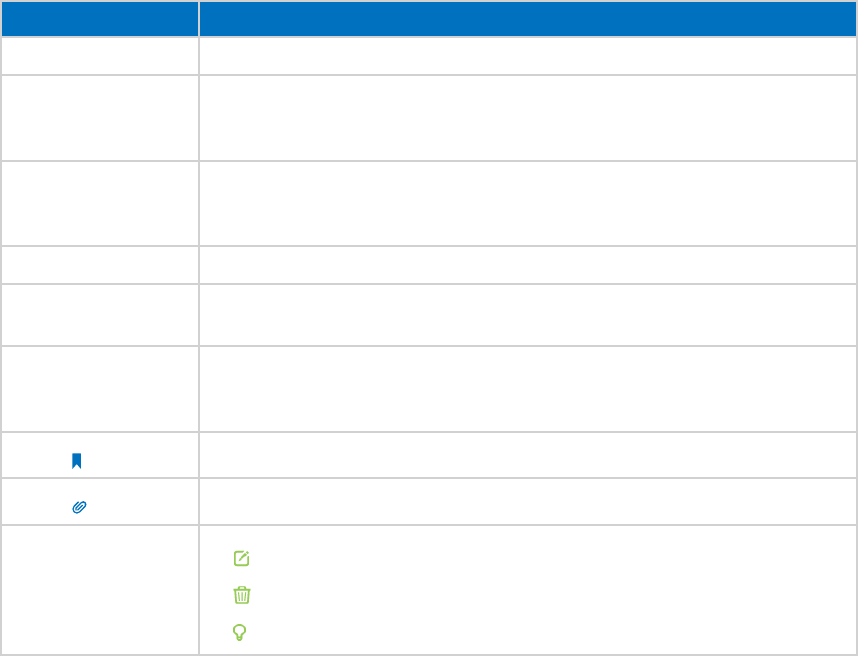
1
About This Guide
This guide provides details of each function and shows how to configure the router
appropriate to your needs. In addition to this guide, a Quick Installation Guide is also
released with each TP-LINK router, you are suggested to configure your router for quick
Internet setup by following the published Quick Installation Guide before you get
started with a further configuration.
Conventions
In this guide the following conventions are used:
Convention Description
router Stands for AC3150 wireless MU-MIMO Gigabit router without any explanation.
parameters
Parameters provided in the screenshots are just references for setting up the device,
which may differ from the actual situation. You can set the parameters according to
your demand.
screenshots
The demonstrated screenshots may look a little different from the actual web page of
your device due to the various firmware versions. Please just configure your product
based on the actual web page.
Blue Italic Hyperlinks are in blue italic. You can click to redirect to a website or a specific section.
Blue Contents to be emphasized and texts on the web page are in blue, including the
menus, items, buttons, etc.
>
The menu structures to show the path to load the corresponding page. For example,
Advanced > Wireless > MAC Filtering means the MAC Filtering function page is under
the Wireless menu that is located in the Advanced tab.
Note: Ignoring this type of note might result in a malfunction or damage to the device.
Tips: Indicates important information that helps you make better use of your device.
symbols on the web
page
• click to edit the corresponding entry.
• click to delete the corresponding entry.
• click to enable or disable the corresponding entry.

Chapter 1
Get to Know About Your
Router
This chapter introduces what the router can do and
shows its main features and appearance.
This chapter contains the following sections:
• Product Overview
• Main Features
• Panel Layout

3
Chapter 1 Get to Know About Your Router
1. 1. Product Overview
What This Product Does
TP-LINK’s AC3150 wireless MU-MIMO Gigabit router integrates 4-port Switch, Firewall,
NAT-router and Wireless AP. Powered by 4x4 MIMO technology, this router delivers
exceptional range and speed, which can fully meet the need of Small Office/Home
Office (SOHO) networks and the users demanding higher networking performance.
Your wireless connections are radio band selectable to avoid interference in your area,
and the four built-in Gigabit ports supply high-speed connection to your wired devices.
More Wi-Fi for More Devices
The Archer C3150 uses Daul-Band technology to run two separate Wi-Fi channels
at once, creating a network that can connect to more devices without a trade-off in
performance.
Smart Connect helps devices run even faster by assigning them to the best available
channel to balance network demand.
Seamless Streaming and Gaming
With the fastest combined Wi-Fi speed of up to 3165Mbps, the Archer C3150 lets you
simultaneously game online and stream video in 4K Ultra HD across multiple devices
without lag.
Run All Your Devices At Once
A powerful 1.4GHz dual-core CPU and two co-processors easily handle the demand
made on the Archer C3150 ’s network when multiple users are browsing, streaming,
and gaming all at the same time.
Lightning-Fast Wired Performance
External hard drives can connect directly to the Archer C3150 via its USB 3.0 and 2.0
ports, making it easy to share files, photos, music, and video across your network.
The Archer C3150 is also equipped with four Gigabit Ethernet ports that enable blazing
wired speeds 10x greater than Fast Ethernet, helping connected gaming consoles, PCs,
and smart TVs achieve their best performance.
Easy Setup and Use
Set up the Archer C3150 in minutes thanks to its intuitive web interface and the powerful
Tether app. Tether also lets you manage its network settings from any Android or iOS
device, including parental controls and media sharing.

4
Chapter 1 Get to Know About Your Router
1. 2. Main Features
Wireless and Wired Performance
• Complies with IEEE 802.11ac.
• One 10/100/1000M Auto-Negotiation RJ45 Internet port, four 10/100/1000M Auto-
Negotiation RJ45 Ethernet ports, supporting Auto MDI/MDIX.
• Provides a USB 3.0 port and a USB 2.0 port supporting file sharing and print server.
• Provides WPA/WPA2, WPA-PSK/WPA2-PSK authentication, TKIP/AES encryption
security.
• Shares data and Internet access for users, supporting Dynamic IP/Static IP/PPPoE/
PPTP/ L2TP Internet access.
• Supports simultaneous 2.4GHz and 5GHz connections for 3165Mbps of total available
bandwidth.
• Supports Virtual Server, Special Application and DMZ host.
• Supports UPnP, Dynamic DNS, Static Routing.
• Provides Automatic-connection and Scheduled Connection on certain time to the
Internet.
• Built-in NAT and DHCP server supporting static IP address distributing.
• Supports Parental Controls and Access Control.
• Connects Internet on demand and disconnects from the Internet when idle for PPPoE.
• Provides WEP encryption security and wireless LAN ACL (Access Control List).
• Supports Flow Statistics.
• Supports IPv6.
• Supports firmware upgrade and Web management.
• Supports OpenVPN server, PPTP VPN server.
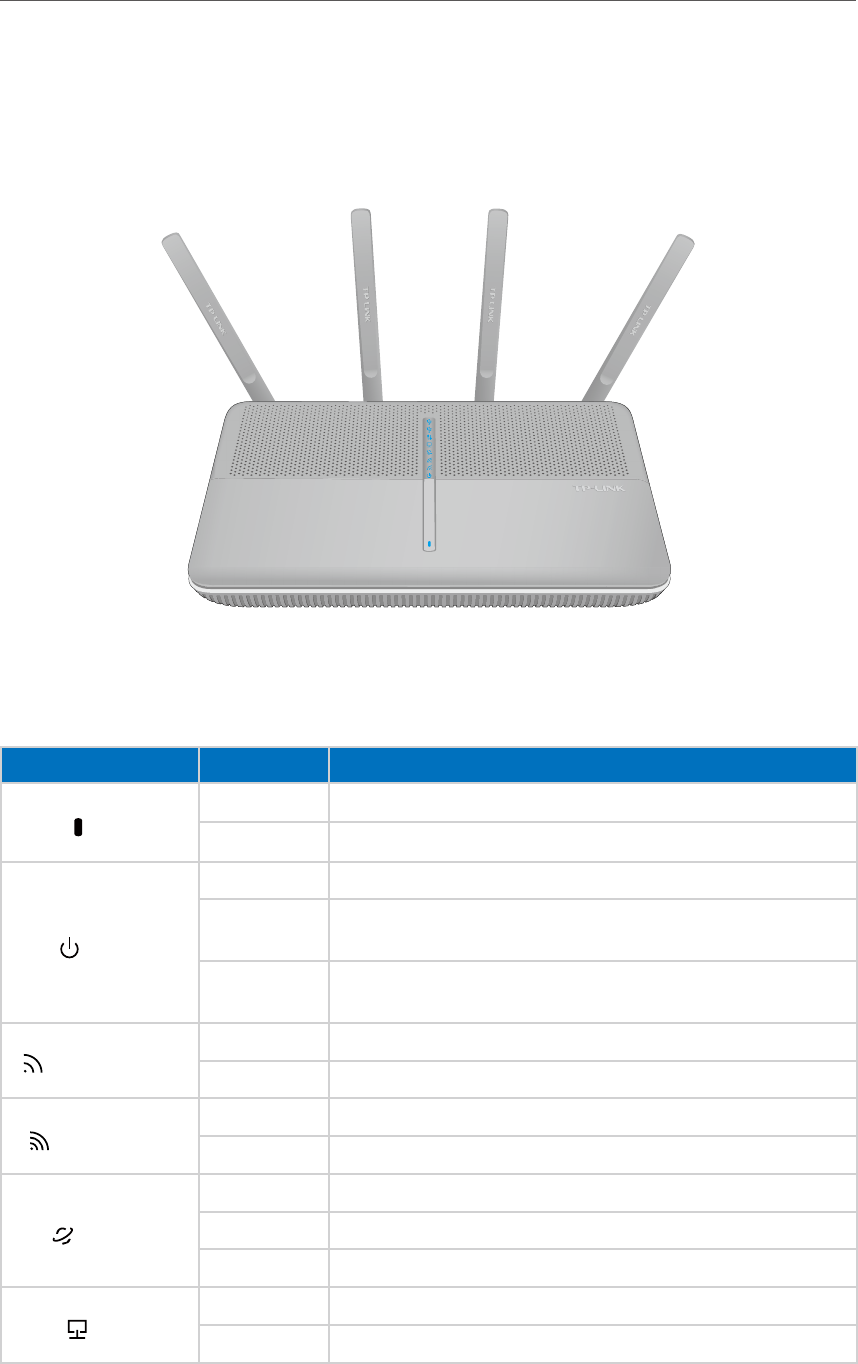
5
Chapter 1 Get to Know About Your Router
1. 3. Panel Layout
1. 3. 1. Front Panel
The router’s LEDs are located on the top panel (view from top to bottom). You can check
the router’s working status by following the LED Explanation table.
LED Explanation
Name Status Indication
(LED)
On All LEDs work normally.
Off All LEDs are off without affecting the router’s performance.
(Power)
On System initialization completes.
Flashing System initialization or firmware upgrade is in process. Do not
disconnect or power off the router.
Off Power is off. Please ensure that the power adapter is connected
correctly.
(Wireless 2.4GHz)
On The wireless 2.4GHz band is working properly.
Off The wireless 2.4 GHz band is disabled.
(Wireless 5GHz)
On The wireless 5GHz band is working properly.
Off The wireless 5GHz band is disabled.
(Internet)
White The router is connected to the Internet.
Orange The WAN port is connected, but there is no Internet connection.
Off The WAN port is not connected.
(LAN)
On At least one LAN port is connected.
Off No LAN port is connected.
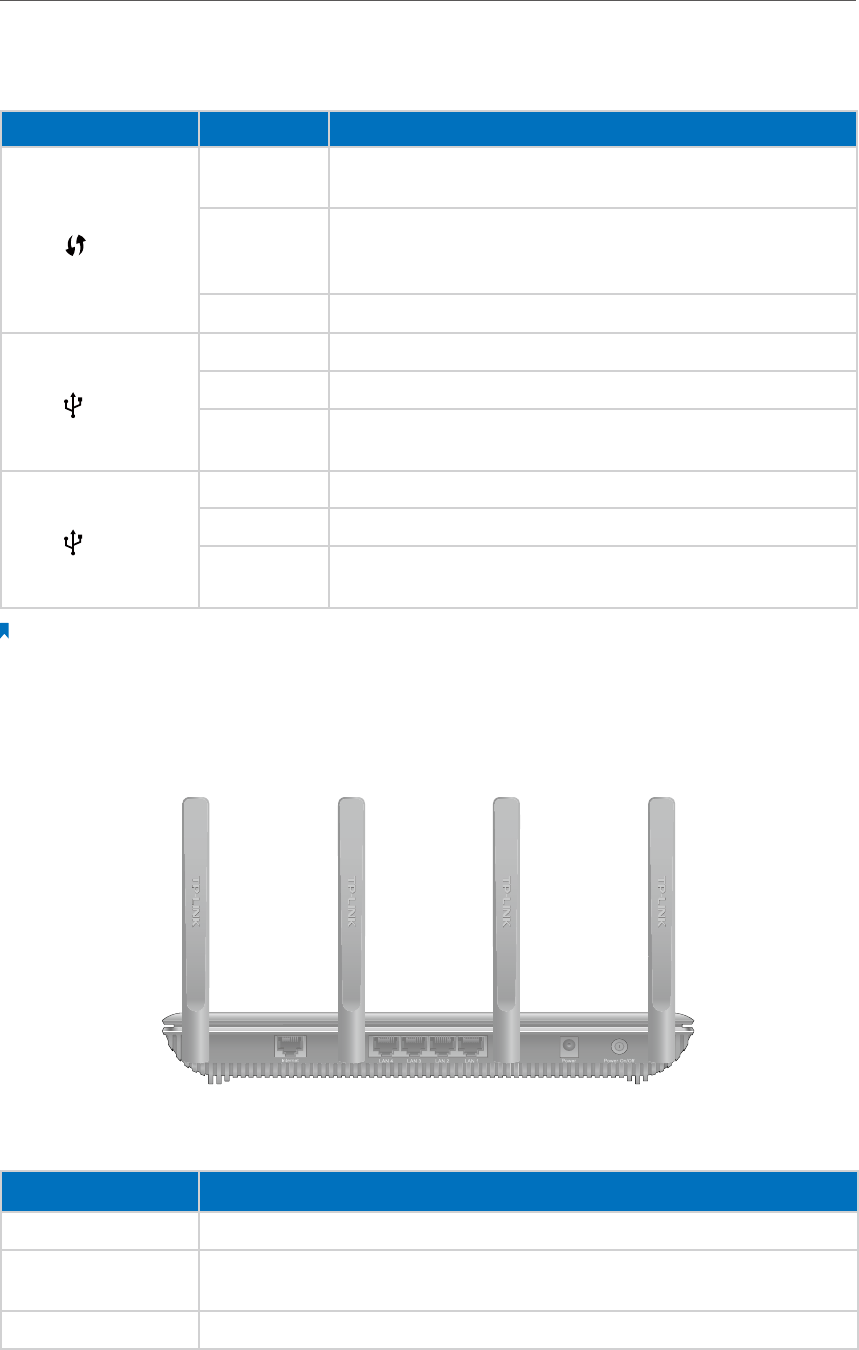
6
Chapter 1 Get to Know About Your Router
LED Explanation
Name Status Indication
(WPS)
On A wireless device has been successfully added to the network by
WPS function.
Flashing
WPS handshaking is in process and will continue for about 2 minutes.
Please press the WPS button on other wireless devices that you want
to add to the network while the LED is flashing.
Off The router is not in the WPS process.
(USB1)
On The USB 3.0 device is identified and ready to use.
Flashing The USB 3.0 device is being identified.
Off No USB 3.0 device is plugged into the USB port or the USB device is
not identified or USB device has been safely ejected.
(USB2)
On The USB 2.0 device is identified and ready to use.
Flashing The USB 2.0 device is being identified.
Off No USB 2.0 device is plugged into the USB port or the USB device is
not identified or USB device has been safely ejected.
Note:
After a device is successfully added to the network by WPS function, the WPS LED will keep on for about 5 minutes
and then turn off.
1. 3. 2. The Back Panel
The router’s back panel shows the connection ports, buttons and antennas (view from
left to right). Refer to the following for detailed instructions.
Item Description
Internet This port is where you will connect the DSL/cable Modem, or Ethernet.
LAN1, LAN2, LAN3,
LAN4 These ports (1, 2, 3, 4) connect the router to the local PC(s).
Power For connecting the router to power socket via the provided power adapter.
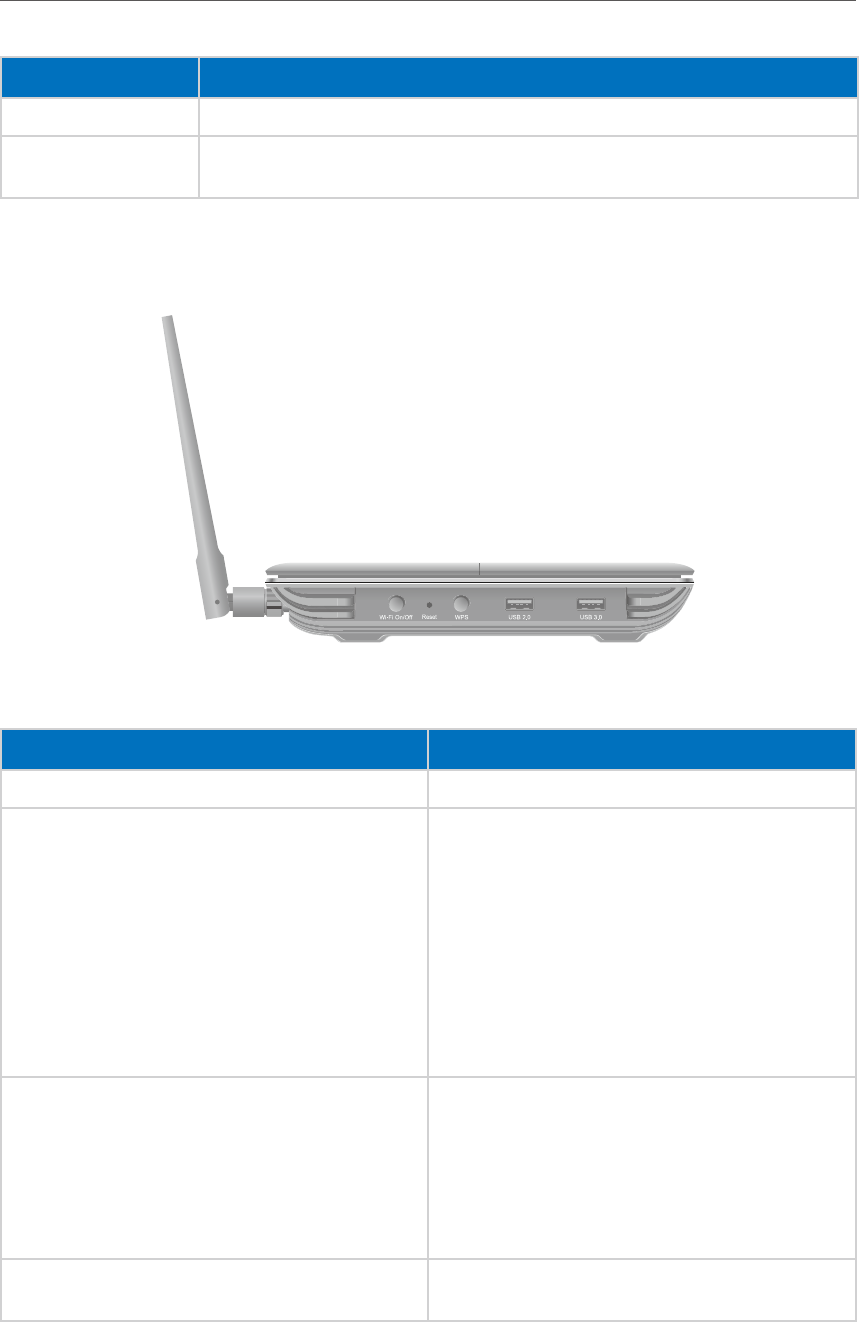
7
Chapter 1 Get to Know About Your Router
Item Description
Power On/Off The switch for the power. Press it to power on or off the router.
Antennas Used for wireless operation and data transmit. Upright them for the best Wi-Fi
performance.
1. 3. 3. The Side Panel
The router’s side panel shows the USB ports and buttons (view from left to right). Refer
to the following for detailed instructions.
Item Description
WiFi On/Off For turning on/off the WiFi function.
Reset
The switch for the reset function. There are two ways to
reset the router’s factory defaults.
Method one: With the router powered on, press and
hold the Reset button for at least 5 seconds until all
LEDs light on (wireless LEDs may not light on if the WiFi
on/off button is off). And then release the button and
wait the router to reboot to its factory default settings.
Method two: Restore the default setting from 13.
4. Backup and Restore Configuration Settings of the
router’s Web-based Management.
WPS
The switch for the WPS function. Pressing this button
for less than 5 seconds enables the WPS function. If
your client devices, such as wireless adapters, that
support Wi-Fi Protected Setup, then you can press this
button to quickly establish a connection between the
router and client devices and automatically configure
wireless security for your wireless network.
USB 2.0 For connecting to a 2.0 USB storage device or a 2.0 USB
printer.

8
Chapter 1 Get to Know About Your Router
Item Description
USB 3.0 For connecting to a 3.0 USB storage device or a 3.0 USB
printer. It is also compatible with USB 2.0 devices.

Chapter 2
Connect the Hardware
This chapter contains the following sections:
• Position Your Router
• Connect Your Router
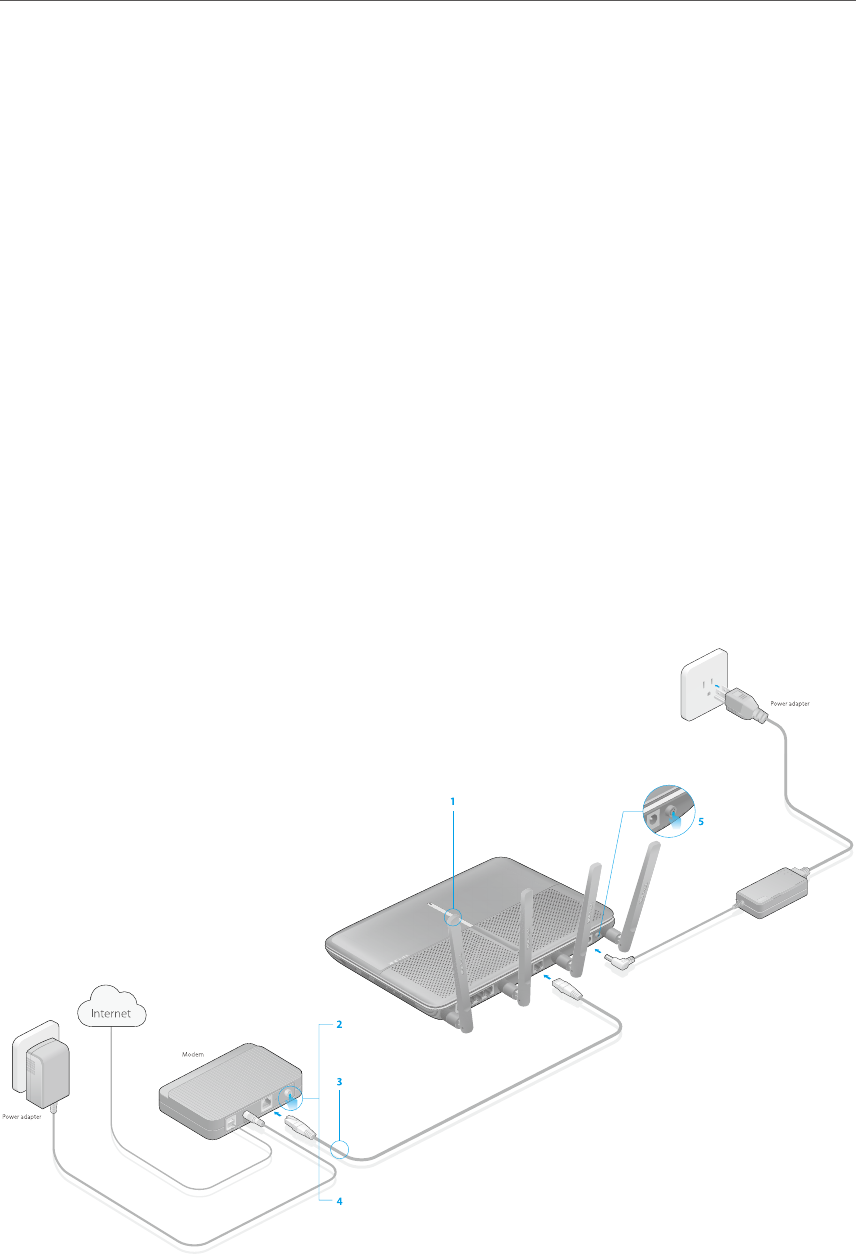
10
Chapter 2 Connect the Hardware
2. 1. Position Your Router
• The Product should not be located where it will be exposed to moisture or excessive
heat.
• Place the router in a location where it can be connected to the various devices as well
as to a power source.
• Make sure the cables and power cord are safely placed out of the way so they do not
create a tripping hazard.
• The router can be placed on a shelf or desktop.
2. 2. Connect Your Router
Follow the steps below to connect your router.
1. If your Internet connection is through an Ethernet cable from the wall instead of
through a DSL / Cable / Satellite modem, connect the Ethernet cable directly to
the router’s Internet port, then follow steps 5) and 6) to complete the hardware
connection.
Router
1 ) Install the antennas and position them vertically for best signal reception.
2 ) Turn off the modem, and remove the backup battery if it has one.
3 ) Connect the modem to the Internet port on your router with an Ethernet cable.

11
Chapter 2 Connect the Hardware
4 ) Turn on the modem, and then wait about 2 minutes for it to restart.
5 ) Turn on the router.
6 ) Verify that the following LEDs are on and solid before continuing with the
configuration.
Power
On On
Internet
2.4G
On
5G
On
Note:
If the 2.4G LED and 5G LED are off, please press the Wi-Fi On/Off button on the side panel for 2 seconds
and check the LEDs again in a few seconds later.
Tips:
For optimum performance, orient the four antennas as shown in the drawing below.
30
°3
0°
2. Connect your computer to the router.
• Method 1: Wired
Turn off the Wi-Fi on your computer and connect the devices as shown below.
Ethernet cable
• Method 2: Wirelessly
Connect wirelessly by using the SSID (Network Name) and Wireless Password/PIN
printed on the product label at the bottom of the router.
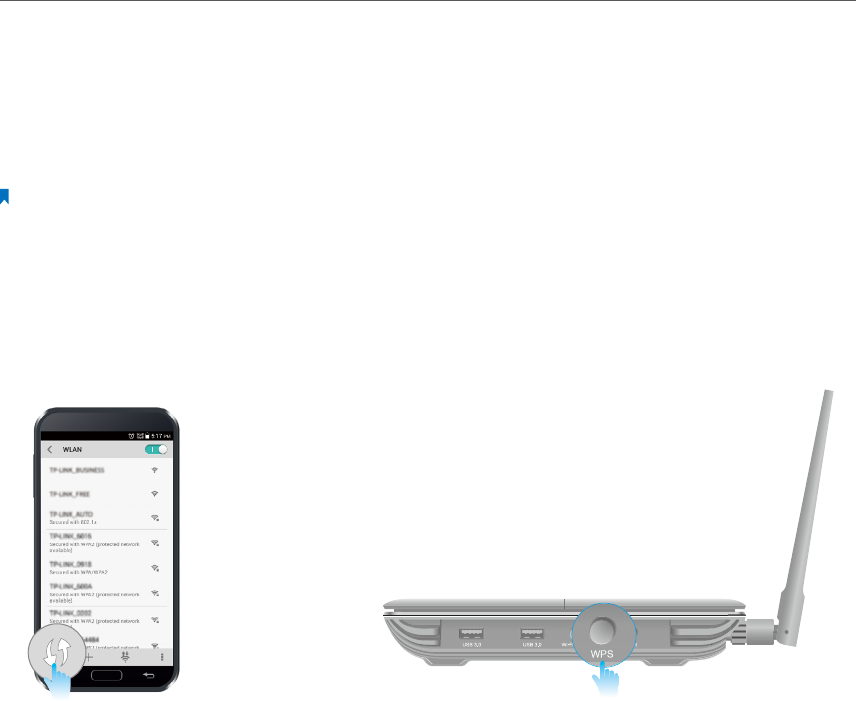
12
Chapter 2 Connect the Hardware
• Method 3: Use the WPS button
Wireless devices that support WPS, including Android phones, tablets, most USB
network cards, can be connected to your router through this method.(WPS is not
supported by IOS devices.)
Note:
The WPS function cannot be configured if the wireless function of the router is disabled. Also, the WPS function will
be disabled if your wireless encryption is WEP. Please make sure the wireless function is enabled and is configured
with the appropriate encryption before configuring the WPS.
1. Tab the WPS icon on the device’s screen.
2. Immediately press the WPS button on your router.
close

Chapter 3
Log into Your Router
With a Web-based utility, it is easy to configure and manage the router. The Web-
based utility can be used on any Windows, Macintosh or UNIX OS with a Web browser,
such as Microsoft Internet Explorer, Mozilla Firefox or Apple Safari.
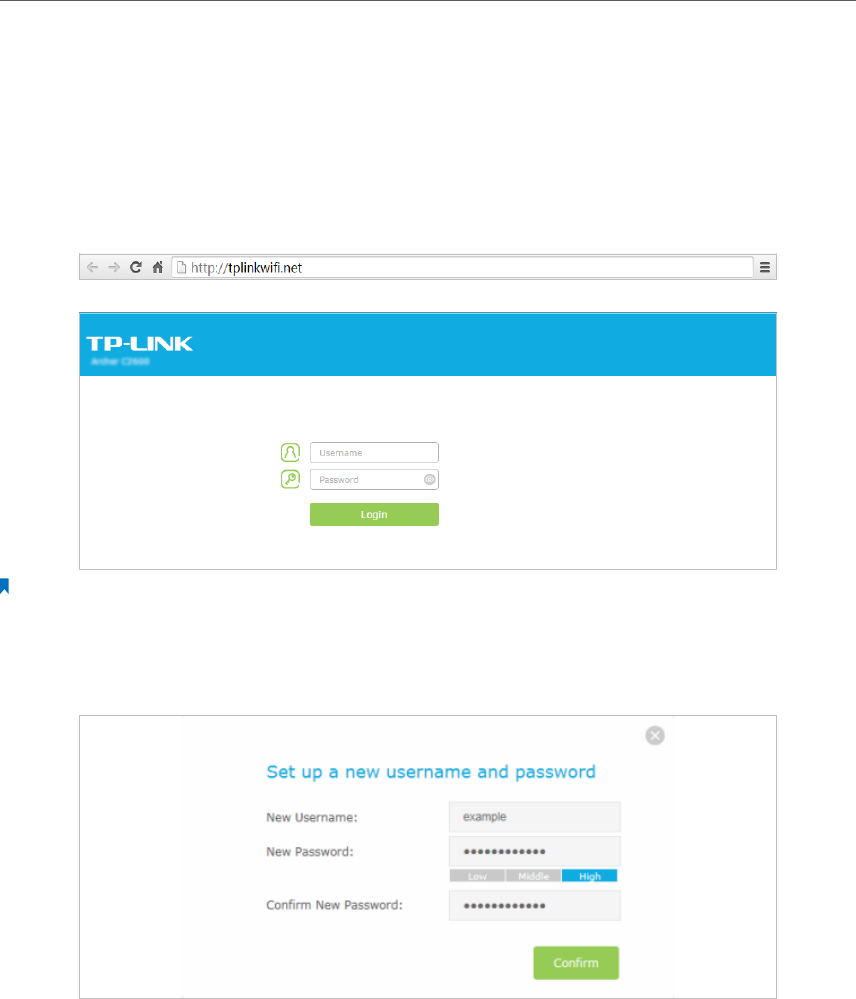
14
Chapter 3 Log into Your Router
Follow the steps below to log into your router.
1. Set up the TCP/IP Protocol in Obtain an IP address automatically mode on your
computer.
2. Launch a web browser and type in http://tplinkwifi.net or http://192.168.0.1. Use
admin for both username and password, and click Login.
Note:
If the login window does not appear, please refer to FAQ > Q3. I cannot login to the router’s web management page,
what can I do?
3. Create a new username and password for subsequent login.

Chapter 4
Set Up Internet
Connections
This chapter introduces how to connect your router to the Internet. The router is
equipped with a web-based Quick Setup wizard. It has many ISP information built
in, automates many of the steps and verifies that those steps have been successfully
completed. Furthermore, you can also set up an IPv6 connection if your ISP provided
IPv6 service.
This chapter contains the following sections:
• Quick Setup
• Manually Configure Your Internet Connection Settings
• Setting Up an IPv6 Internet Connection
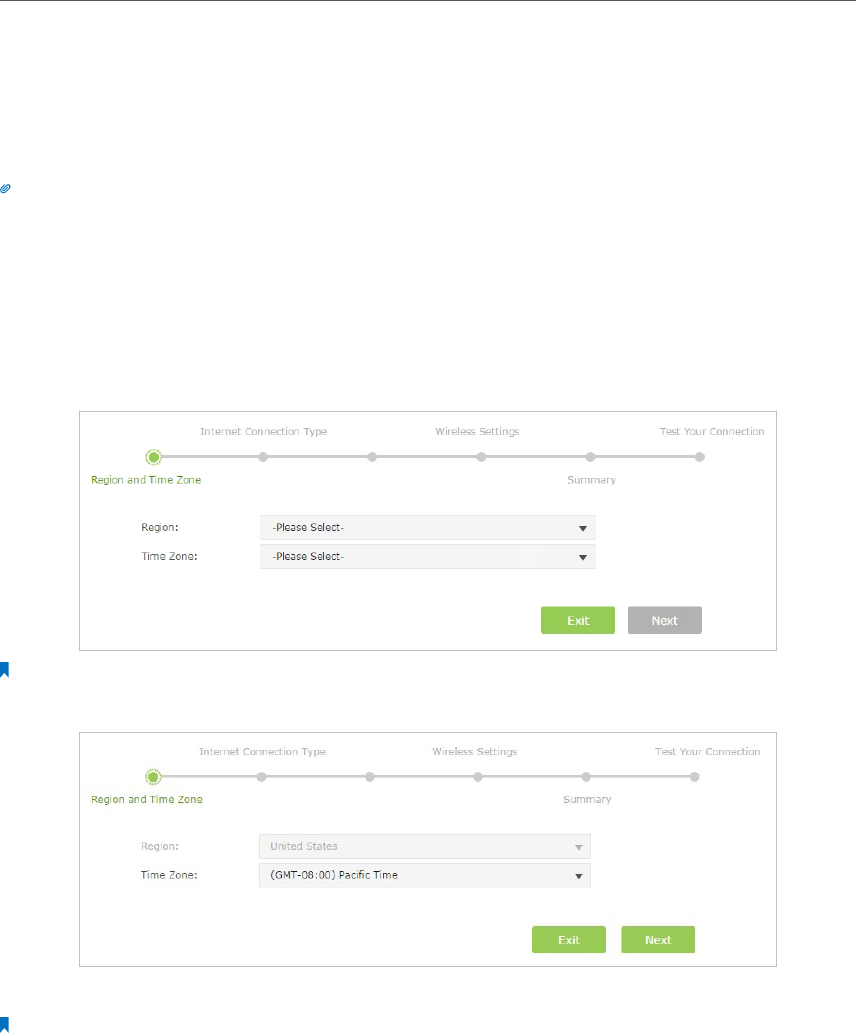
16
Chapter 4 Set Up Internet Connections
4. 1. Quick Setup
The Quick Setup Wizard will guide you through the process to set up your router to
access the Internet.
Tips:
If you need the IPv6 Internet connection, please refer to the section of 4. 3. Setting Up an IPv6 Internet Connection.
Follow the steps below to set up your router to access the Internet.
1. Visit http://tplinkwifi.net, and log in with the password you set for the router.
2. Go to Quick Setup on the top of the page.
3. Select your Region and Time Zone from the drop-down list and click Next.
Note:
Per FCC regulations, all Wi-Fi products marketed in the U.S. must be fixed to the U.S. region only.
4. Click Auto Detect and the router will detect your connection type automatically.
Note:
You can also choose the connection type manually. If you use DSL line and you are only provided an account name
and a password by your ISP, choose PPPoE. If you use cable TV or fiber cable, choose Dynamic IP. If you are provided
more information such as IP address, Subnet Mask and Default Gateway, choose Static IP. Contact your ISP if you are
not sure about the Internet connection information.
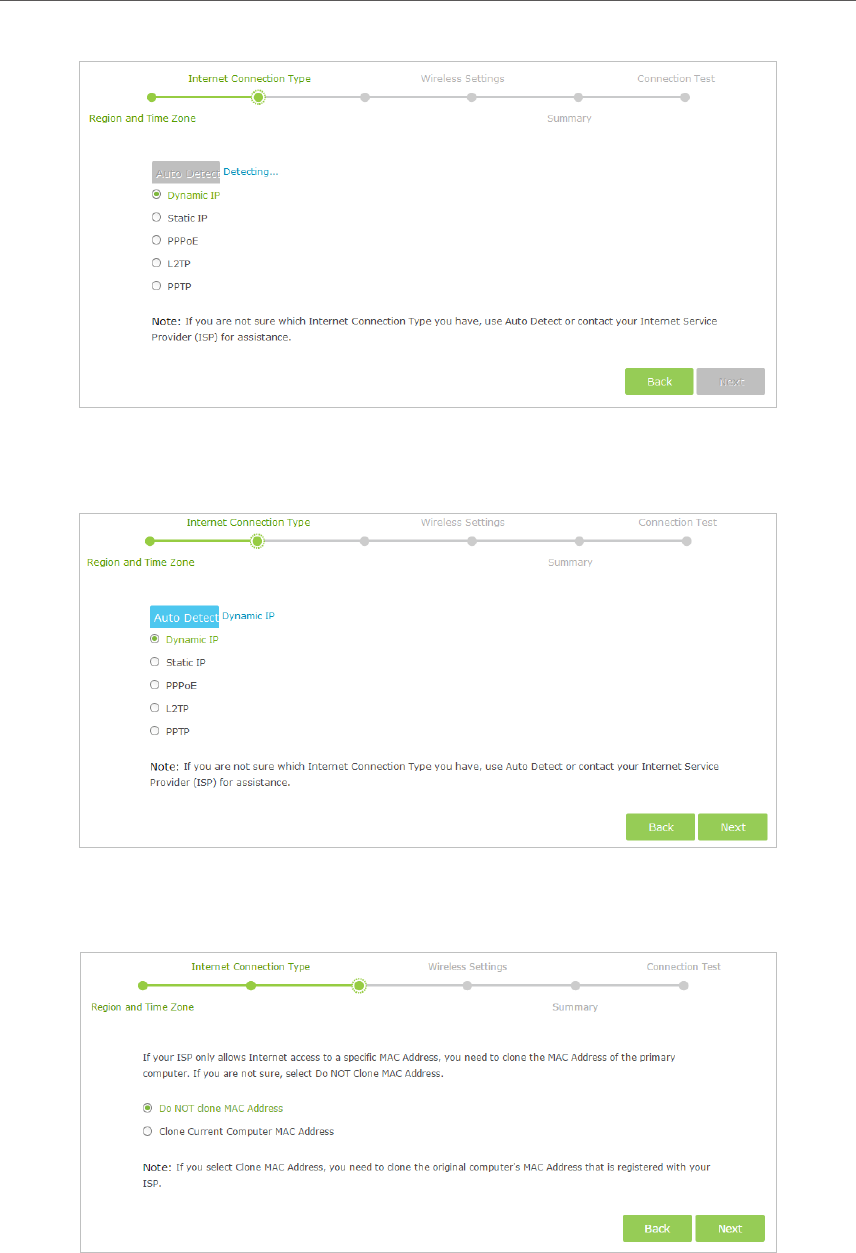
17
Chapter 4 Set Up Internet Connections
5. In this case, the router automatically detects Dynamic IP as the connection type.
Click Next.
6. Follow the instructions on the page to decide whether to clone MAC Address. Click
Next.
7. Configure your wireless settings and click Next.
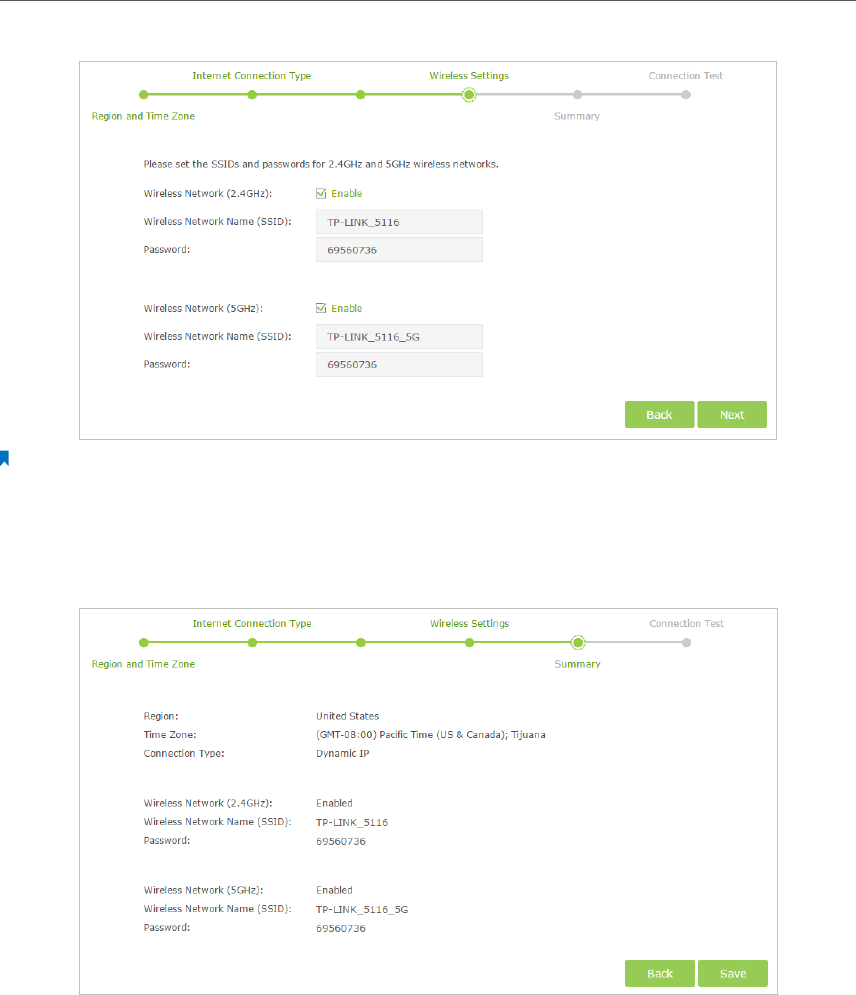
18
Chapter 4 Set Up Internet Connections
Note:
1. You may customize your 2.4GHz/5GHz SSID and password. Once done, the wireless connection will disconnect
automatically, and you must then use the new SSID/password to regain access to the Internet.
2. Tick Hide SSID if you want to hide this wireless network name.
8. Confirm the information and click Save.
9. Click Test Internet Connection.If you successfully connect to the Internet, the screen
will display as follows.
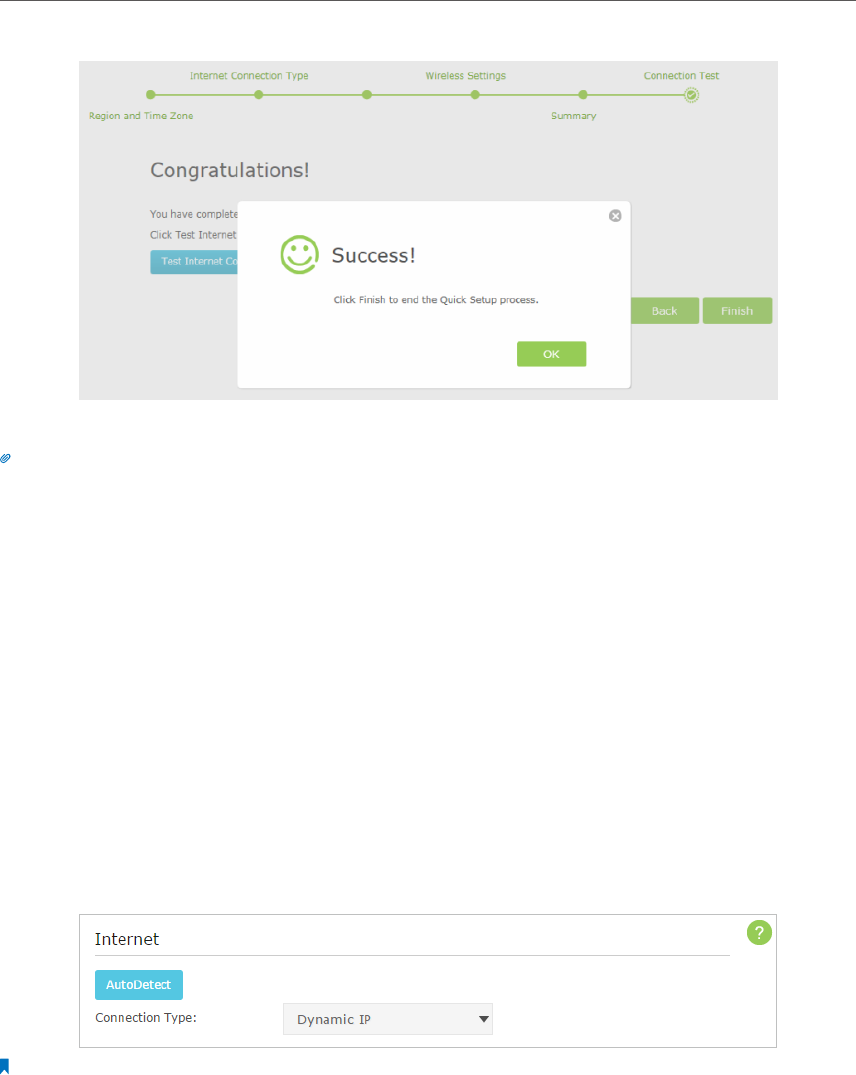
19
Chapter 4 Set Up Internet Connections
10. Now your computer and WiFi device can connect to the Internet!
Tips:
You can connect your computer to the router’s LAN port using an Ethernet cable to join the local area network. You
can also find and select the wireless network name on your WiFi device to join the WiFi network.
4. 2. Manually Configure Your Internet Connection
Settings
In this part, you can check your current Internet connection settings. You can also
modify the settings according to the service information provided by your ISP.
Follow the steps below to check or modify your Internet connection settings.
1. Visit http://tplinkwifi.net, and log in with the password you set for the router.
2. Go to Basic > Internet on the left to enter the setting page.
3. Select your Internet connection type from the drop-down list.
Note:
If you are unsure what your connection type is, click Auto Detect. Since different connection types need different
cables and connection information, you can also refer to the demonstrations in Step 4 to judge your connection
type.
4. Follow the instructions on the page to continue the configuration. Parameters on the
figures are just used for demonstration.
1 ) If you choose Dynamic IP, you need to select whether to clone the MAC address.
Dynamic IP users are usually equipped with cable TV or fiber cable.
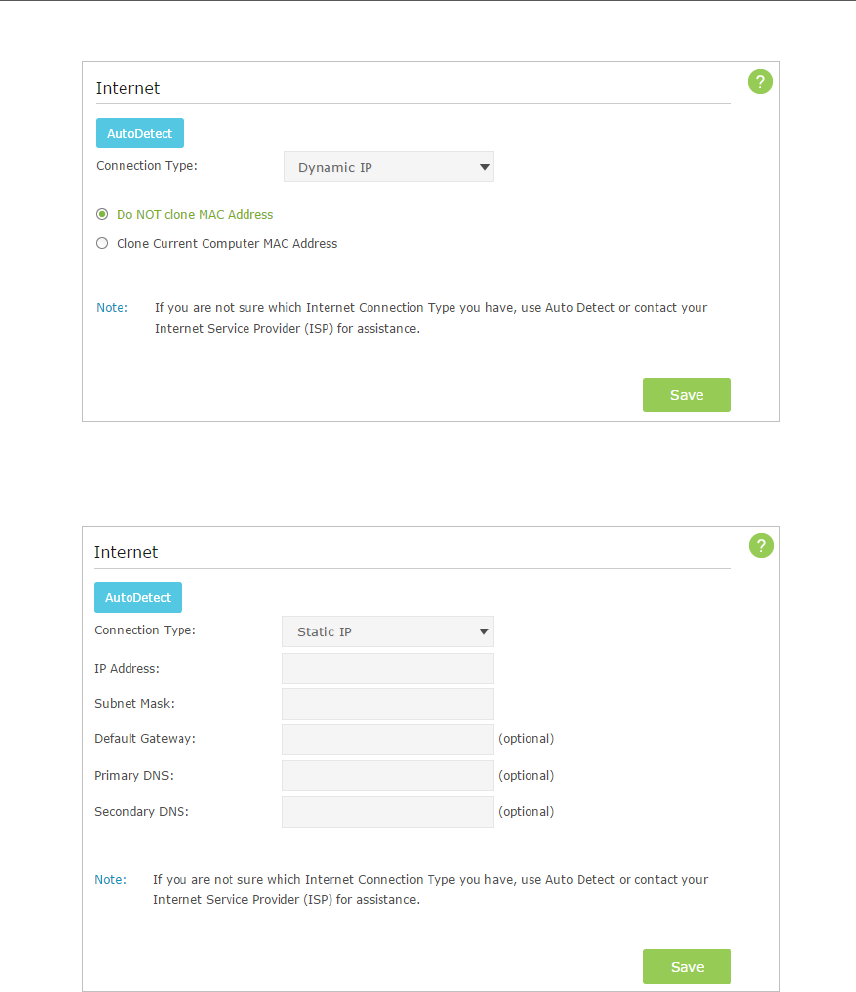
20
Chapter 4 Set Up Internet Connections
2 ) If you choose Static IP, enter the information provided by your ISP in the
corresponding fields.
3 ) If you choose PPPoE, enter the username and password provided by your ISP.
PPPoE users usually have DSL cable.
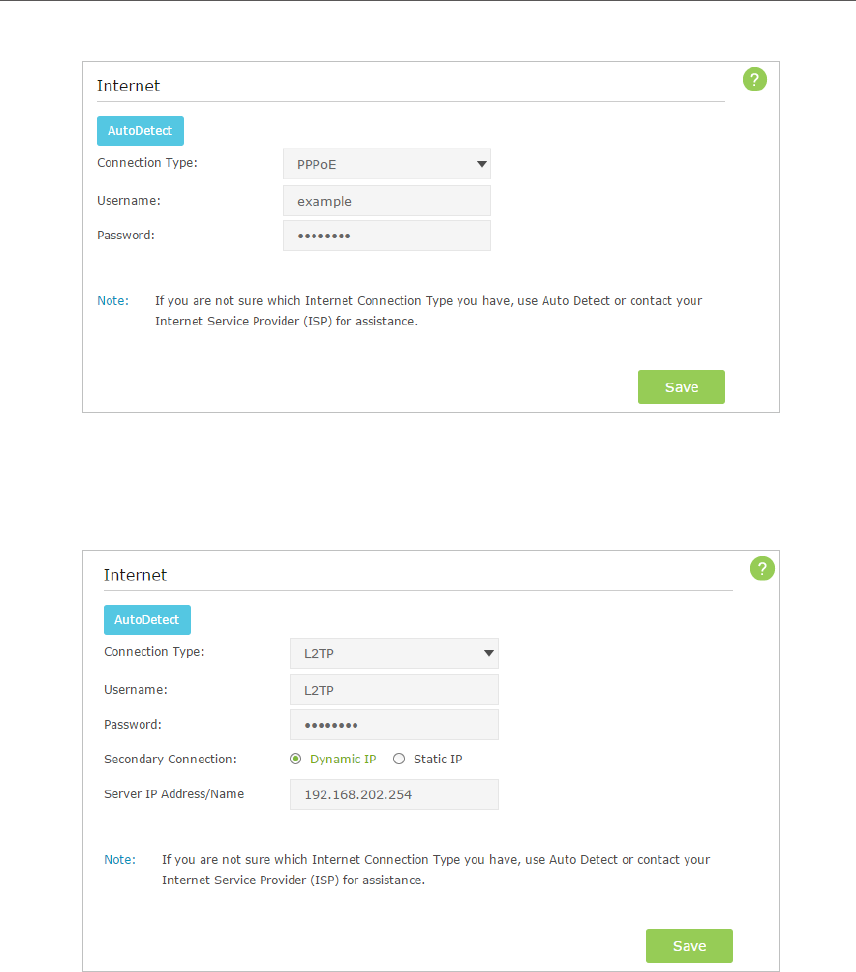
21
Chapter 4 Set Up Internet Connections
4 ) If you choose L2TP, enter the username and password and choose the Secondary
Connection provided by your ISP. Different parameters are needed according
to the Secondary Connection.
5 ) If you choose PPTP, enter the username, password and choose the Secondary
Connection provided by your ISP. Different parameters are needed according
to the Secondary Connection.
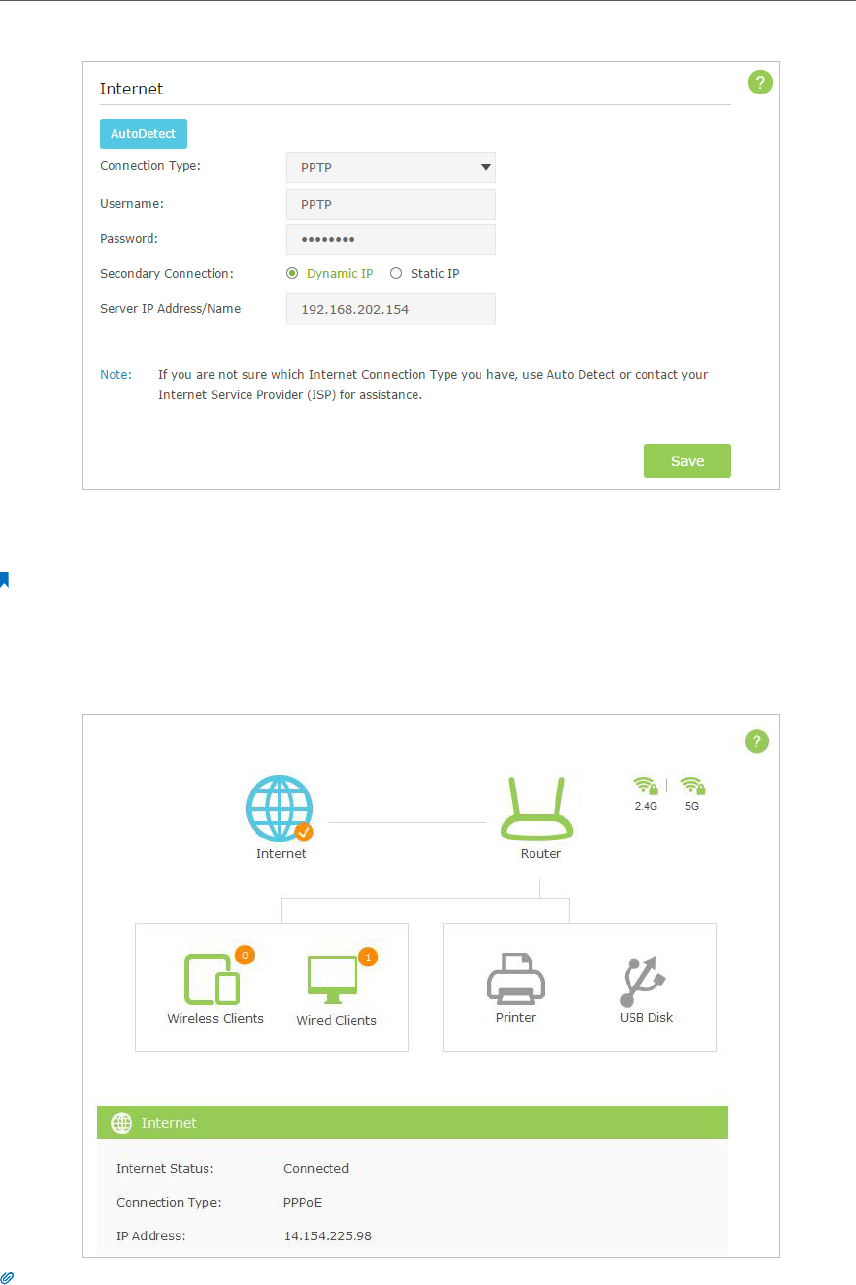
22
Chapter 4 Set Up Internet Connections
5. Click Save to make the settings take effect. To check your Internet connection, click
Network Map on the left of the page.
Note:
It may take 1-2 minutes to make the settings valid.
6. After the connection succeed, the screen will display as follows. Here we take PPPoE
as an example.
Tips:
1. If you use Dynamic IP and PPPoE and you are provided any other parameters that are not required on the page,
please go to Advanced > Network > Internet to complete the configuration.
2. If you still cannot connect to the Internet, refer to FAQ for further instructions.
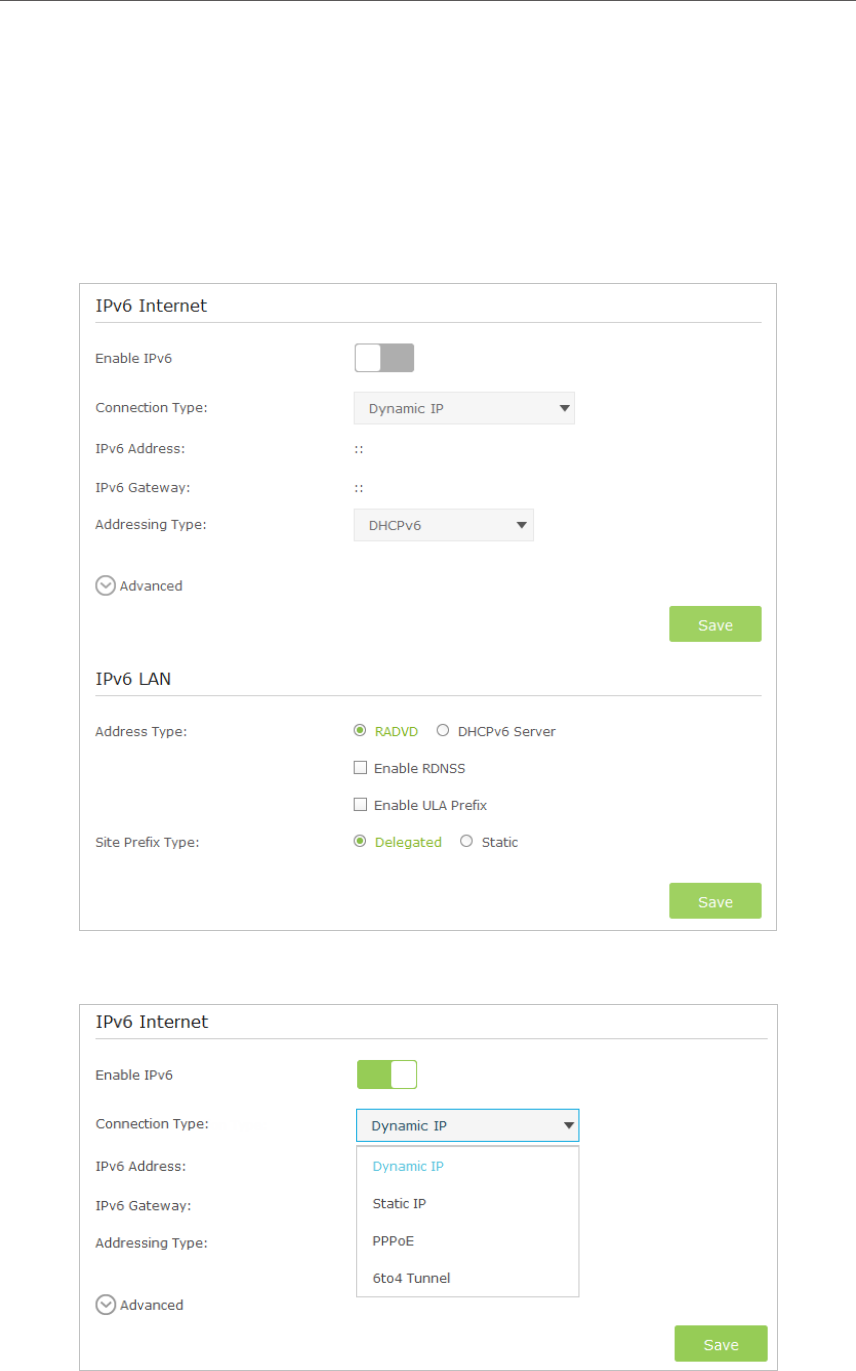
23
Chapter 4 Set Up Internet Connections
4. 3. Setting Up an IPv6 Internet Connection
Your ISP provides information about one of the following Internet connection types:
PPPoE, Dynamic IP(SLAAC/DHCPv6), Static IP, 6to4 tunnel.
1. Visit http://tplinkwifi.net, then log in with the password you set for the router.
2. Go to Advanced > IPv6 to log into the configuration page.
3. Select the Internet connection type provided by ISP.
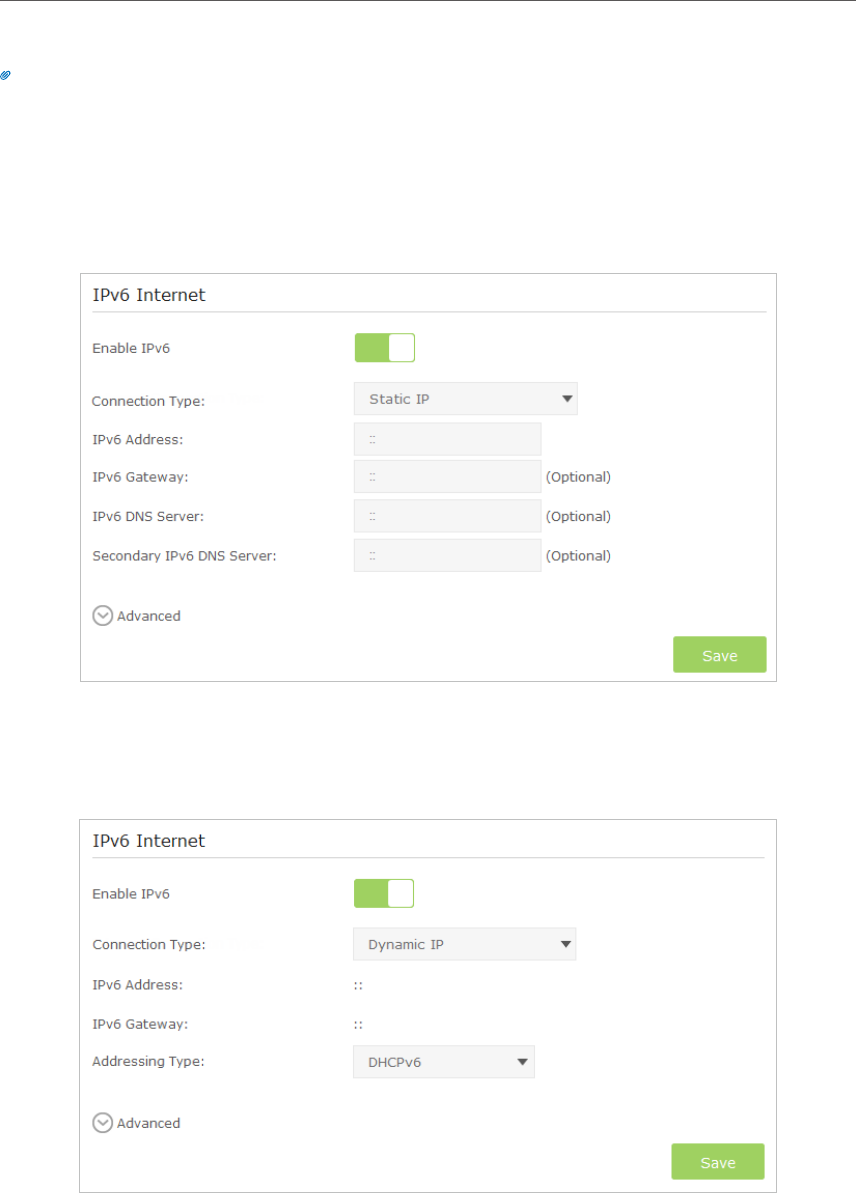
24
Chapter 4 Set Up Internet Connections
Tips:
If you do not know what your Internet connection type is, contact your ISP or judge according to already known
information provided by your ISP.
4. Fill in information as required by different connection type. (Red blanks must be
filled.)
1 ) Static IP: Fill in blanks and click Save.
2 ) Dynamic IP(SLAAC/DHCPv6): Click Advanced to have more configuration if
ISP requires. Click Save to save the settings and then click Renew to finish the
configuration.
3 ) PPPoE: Fill in the Username and Password. Click Advanced to have more
configuration if ISP requires. Click Save to save the settings and then click
Connect to finish the configuration.
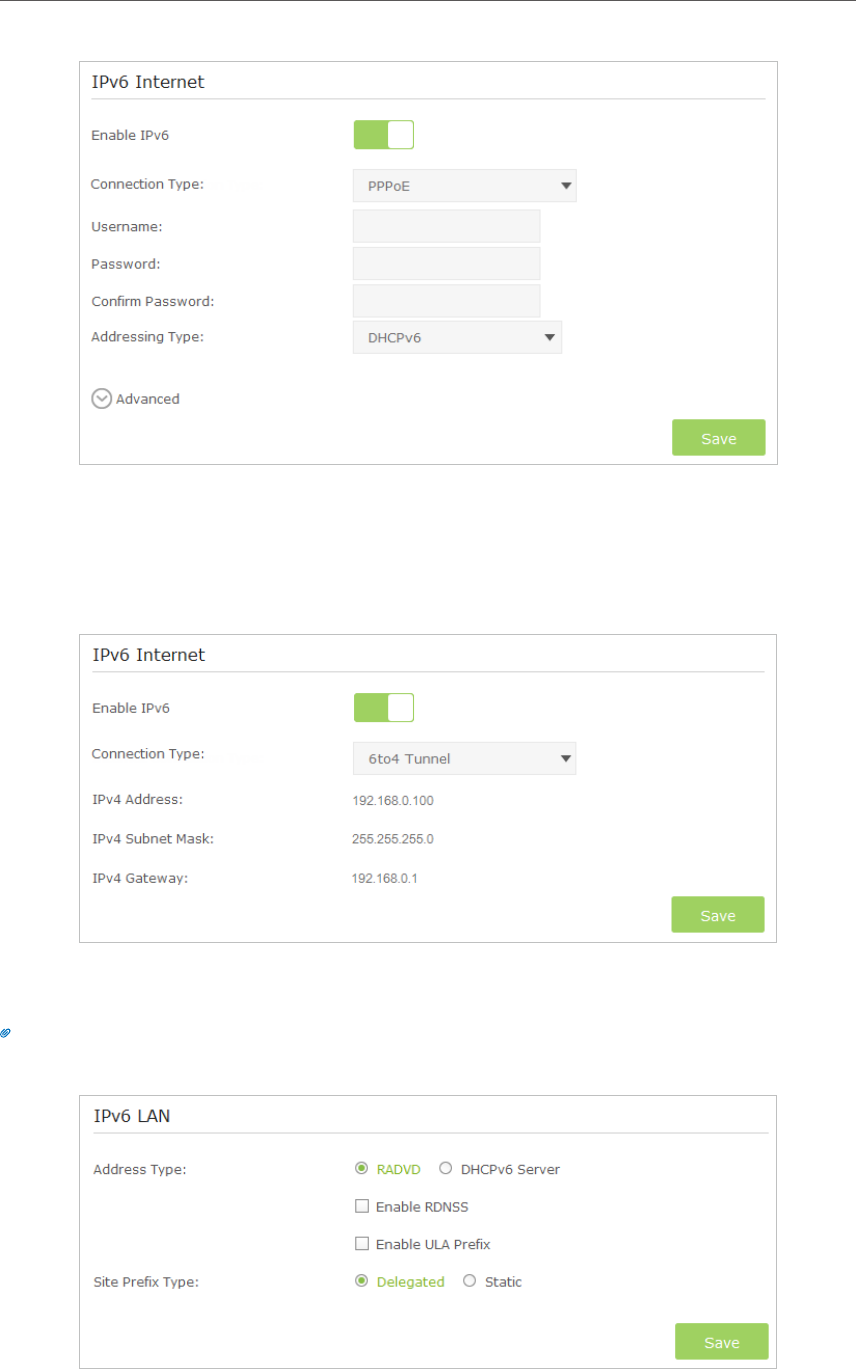
25
Chapter 4 Set Up Internet Connections
4 ) 6to4 Tunnel: An IPv4 Internet connection type is a prerequisite for this
connection type. (4. 2) Click Advanced to have more configuration if ISP
requires. Click Save to save the settings and then click Connect to finish the
configuration.
5. Configure LAN ports. Windows users are recommended to choose from the first two
types. Fill in Address Prefix provided by ISP, and click Save to save the settings.
Tips:
Find Help on the management interface to know more about items.
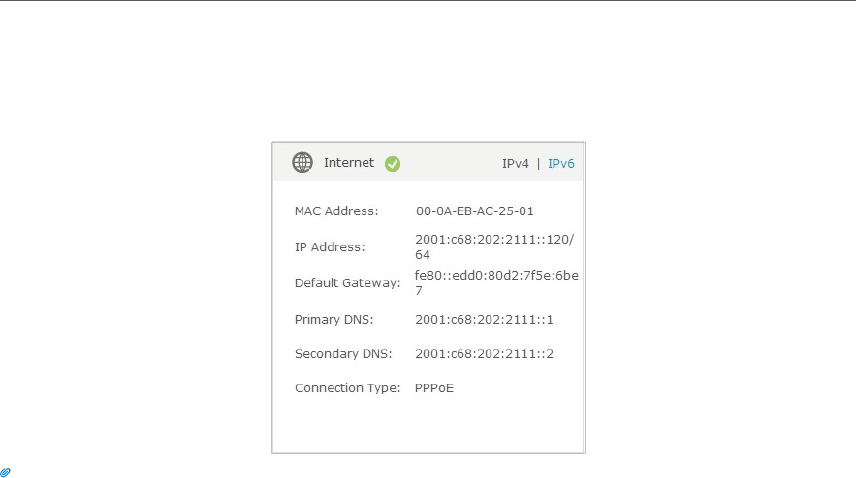
26
Chapter 4 Set Up Internet Connections
6. Click Status to check whether you succeed or not. The following figure is an example
of a successful PPPoE configuration.
Tips:
Visit FAQ if there is no Internet connection.

Chapter 5
Guest Network
This function allows you to provide Wi-Fi access for guests without disclosing your
main network. When you have guests in your house, apartment, or workplace, you can
create a guest network for them. In addition, you can limit the network authorities for
guests to ensure network security and privacy.
This chapter contains the following sections:
• Create Guest Network
• Customize Guest Network Options
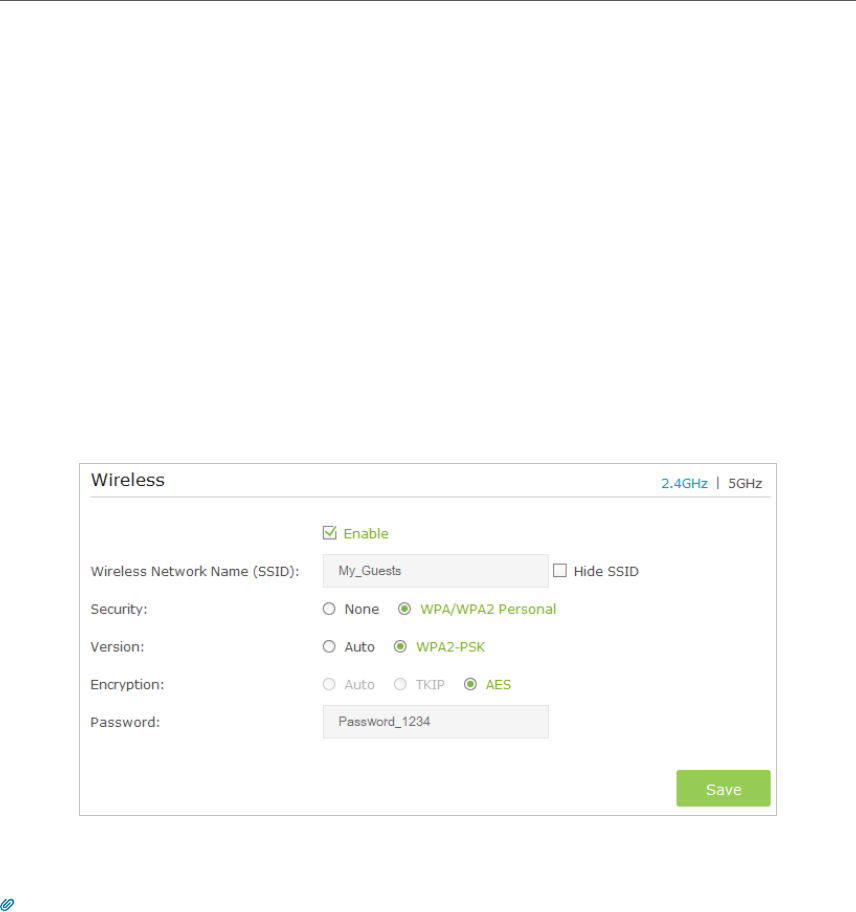
28
Chapter 5 Guest Network
5. 1. Create Guest Network
1. Visit http://tplinkwifi.net, and log in with the username and password you set for the
router.
2. Go to Advanced > Guest Network.
3. Create a 2.4GHz or 5GHz guest network according to your needs.
1 ) Click 2.4GHz, 5GHz and select Enable.
2 ) Set an easy-to-identify SSID. Don‘t select Hide SSID unless you want your guests
and other people to manually input this SSID for Wi-Fi access.
3 ) Set Security to WPA/WPA2 Personal, keep the default Version and Encryption
values, and set an easy-to-remember password.
4. Click Save. Now your guests can access your guest network using the SSID and
password you set!
Tips:
To view guest network information, go to Advanced > Status and find the Guest Network section.
5. 2. Customize Guest Network Options
1. Visit http://tplinkwifi.net, and log in with the password you set for the router.
2. Go to Advanced > Guest Network.
3. Customize guest network options according to your needs.
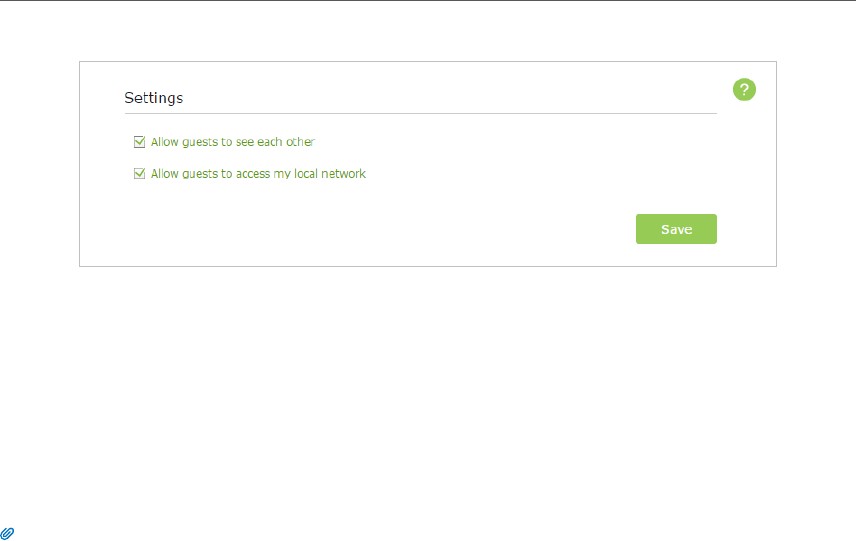
29
Chapter 5 Guest Network
• Allow guests to see each other
Select this checkbox to allow the clients in your guest network to access each other.
• Allow guests to access my local network
Select this checkbox to allow the clients in your guest network to access your local
network, not just Internet access.
4. Click Save. Now users in your guest network can enjoy only the network authorities
you assigned!
Tips:
To view guest network information, go to Advanced > Status and find the Guest Network section.

Chapter 6
USB Application
This chapter describes how to share and access USB devices connected to the router
among different clients.
The router only supports USB external flash drives, hard drives and USB printers, and
does not support USB 3G/4G modems.
This chapter contains the following sections:
• Local Storage Sharing
• Customize Your Settings
• Media Sharing
• Printer Sharing

31
Chapter 6 USB Application
6. 1. Local Storage Sharing
Share your USB storage devices with different users on the network.
6. 1. 1. Access the USB disk
1. Connect Your USB Disk
Insert your USB storage device into the router’s USB port directly or using a USB
cable. Wait several seconds until the USB LED becomes solid on.
Tips:
• If you use USB hubs, make sure no more than four devices are connected to the router.
• If the USB storage device requires using bundled external power, make sure the external power has been
connected.
• If you use a USB hard drive, make sure its file system is FAT32, NTFS.
• Before you physically disconnect a USB device from the router, safely remove it to avoid data damage: Go
to Advanced > USB Settings > Device Settings and click Safety Remove.
2. Access Your USB Disk
By default all the network clients can access all folders on your USB disk. Refer to
the following table for access instructions. You can also customize your sharing
content and set a sharing account referring to 6. 1. 2. Customize Your Settings.
Windows
computer
1. Press Windows ( )+ R on the keyboard (or select Start > Run).
2. Type the server address \\tplinkwifi.net or ftp://tplinkwifi.net in the dialog box.
3. Click OK.s
Mac
1. Select Go > Connect to Server.
2. Type the server address smb://tplinkwifi.net or ftp://tplinkwifi.net.
3. Click Connect.
Pad Use a third-party app for network files management.
Tips:
You can also access all folders by using your Network/Media Server Name. Refer to To Customize the Address of
the USB Disk to learn more.
6. 1. 2. Customize Your Settings
¾To Only Share Specific Content
By default, Share All is enabled so all content on the USB disk is shared. If you want to
only share specific folders, follow the steps below:
1. Visit http://tplinkwifi.net, then log in with the username and password you set for the
router.
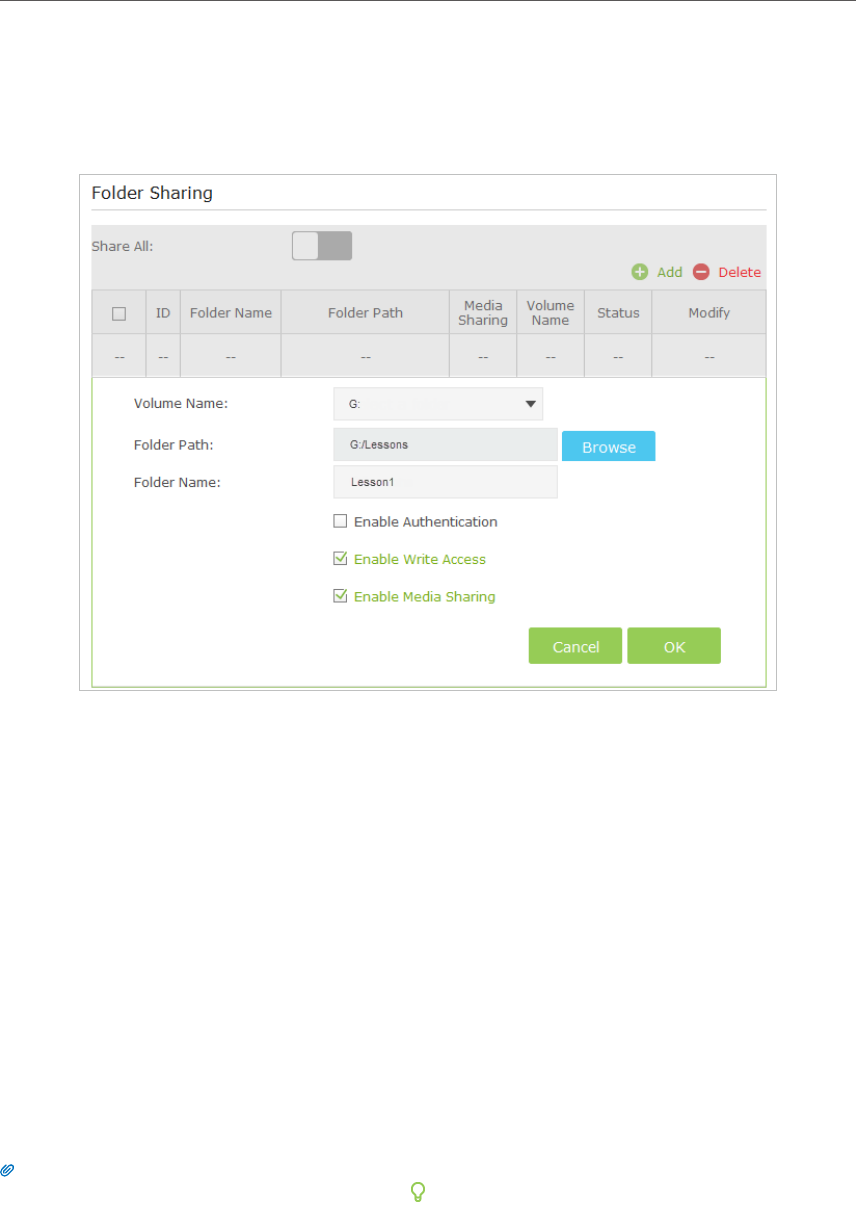
32
Chapter 6 USB Application
2. Go to Basic or Advanced > USB Settings > Sharing Access. Focus on the Folder Sharing
section. Click the button to disable Share All, then click Add to add a new sharing
folder.
3. Select the Volume Name and Folder Path, then enter a Folder Name as you like.
4. Decide the way you share the folder:
• Allow Guest Network Access: If you select this check box, guest network can
access to the this folder.
• Enable Authentication: Select to enable authentication for this folder sharing,
and you will be required to use a username and password to access the USB
disk. Refer to To Set up Authentication for Data Security to learn more.
• Enable Write Access: If you select this check box, network clients can modify
this folder.
• Enable Media Sharing: Select to enable media sharing for this folder, and you
can view photos, play music and watch movies stored on the USB disk directly
from DLNA-supported devices. Click Media Sharing to learn more.
5. Click OK.
Tips:
The router can share 32 volumes at most. You can click on the page to detach the corresponding volume you do
not need to share.
¾To Set up Authentication for Data Security
If you enable Authentication, network clients will be required to enter the username
and password you set when accessing the USB disk.
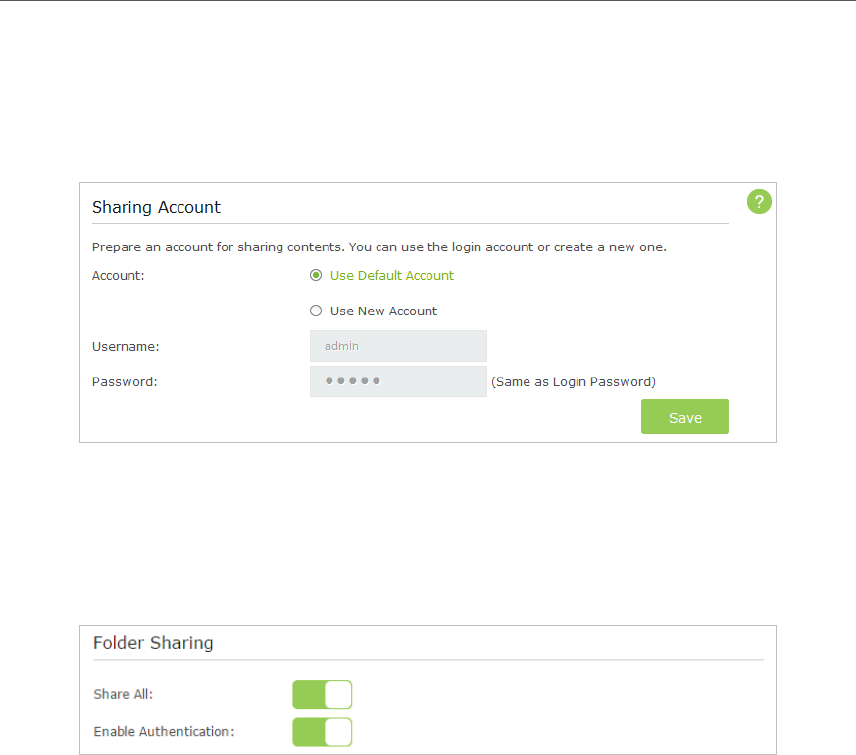
33
Chapter 6 USB Application
1. Visit http://tplinkwifi.net, then log in with the username and password you set for the
router.
2. Go to Advanced > USB Settings > Sharing Access. Focus on the Sharing Account section.
3. Choose to use the default Account (admin) or use a new account and click Save.
4. Enable Authentication to apply the account you just set.
• If you leave Share All enabled, click the button to enable Authentication for all
folders.
• If Share All is disabled, enable Authentication for specific folders.
¾To Customize the Address of the USB Disk
You can customize the server name and use the name to access your USB disk.
1. Visit http://tplinkwifi.net, then log in with the username and password you set for the
router.
2. Go to Advanced > USB Settings > Sharing Access. Focus on the Sharing Settings section
3. Make sure Network Neighborhood is ticked, and enter a Network/Media Server
Name as you like, such as My-Share, then click Save.
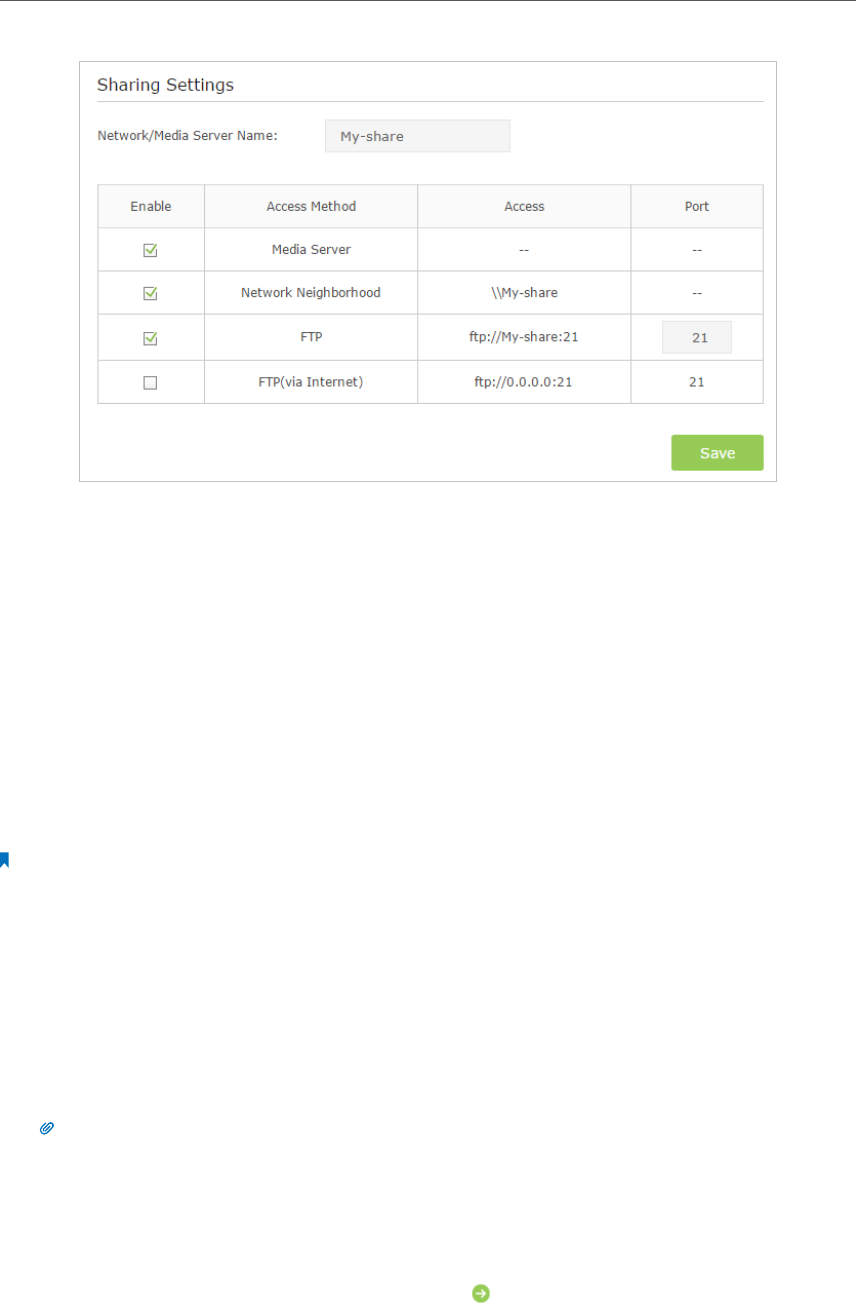
34
Chapter 6 USB Application
4. Now you can access the USB disk with \\My-Share (smb://My-Share for Mac).
6. 2. Remote Access via FTP Server
You can access your USB disk outside the local area network.
For example:
• Share photos and other large files with your friends without logging in to (and paying
for) a photo-sharing site or email system.
• Get a safe backup for the materials for a presentation.
• Remove the files on your camera’s memory card from time to time during the journey.
Note:
If your ISP assigns a private WAN IP address (such as 192.168.x.x or 10.x.x.x), you cannot use this feature because
private addresses are not routed on the Internet.
6. 2. 1. Access the USB disk
1. Connect Your USB Disk
Insert your USB storage device into the router’s USB port directly or using a USB
cable. Wait several seconds until the USB LED becomes solid on.
Tips:
• If you use USB hubs, make sure no more than four devices are connected to the router.
• If the USB storage device requires using bundled external power, make sure the external power has been
connected.
• If you use a USB hard drive, make sure its file system is FAT32,NTFS.
• Before you physically disconnect a USB device from the router, safely remove it to avoid data damage: Go
to Advanced > USB Settings > Device Settings and click Safety Remove.
2. Enable Authentication for Data Security
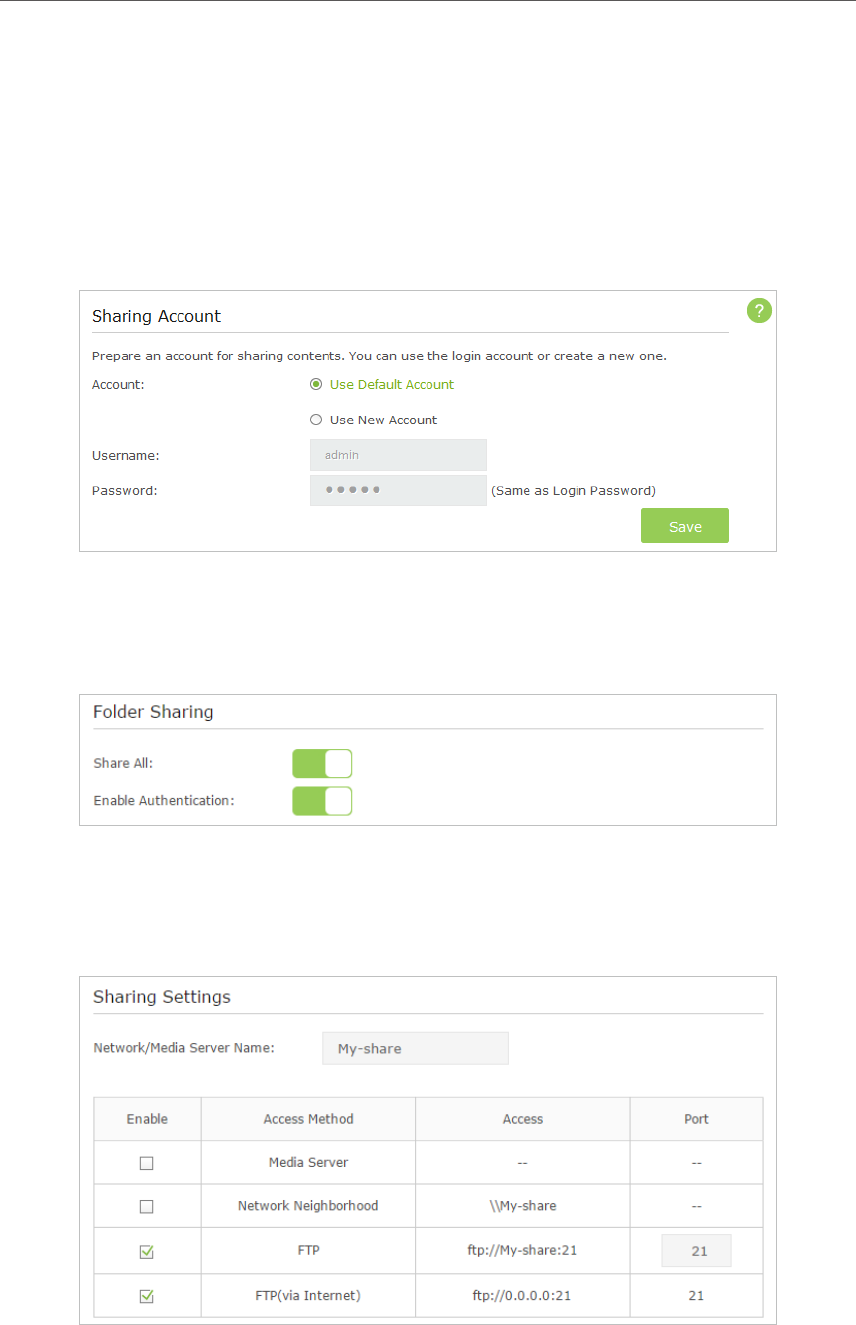
35
Chapter 6 USB Application
It is strongly recommended that you set and apply a sharing account for data
security.
1 ) Visit http://tplinkwifi.net, then log in with the username and password you set
for the router.
2 ) Go to Advanced > USB Settings > Sharing Access.
3 ) Choose to Use default Account (admin) or Use New Account and click Save.
4 ) Enable Authentication to apply the sharing account.
• If you leave Share All enabled, click the button to enable Authentication for all
folders.
• If Share All is disabled, enable Authentication for specific folders.
3. Enable the FTP (via Internet)
Select the check box to enable FTP (via Internet), then click Save.

36
Chapter 6 USB Application
4. Access Your USB Disk via Internet
Now different clients with Internet connection can access the USB disk:
Computer
• To download, open a web browser and type the server address ftp://<WAN
IP address of the router>:<port number> (such as ftp://59.40.2.243:21),
or if you set up a domain name for your router you can type the server
address ftp://<domain name of the router>:<port number> (such as ftp://
MyDomainName:21) in the address bar, then press Enter on the keyboard.
• To upload, use a third-party app for network files management.
Pad • Use a third-party app for network files management.
Tips:
Go to 12. 8. Schedule Your Wireless Function to learn how to set up a domain name for you router.
6. 2. 2. Customize Your Settings
¾To Only Share Specific Content
By default, Share All is enabled so all content on the USB disk is shared. If you want to
only share specific folders, follow the steps below:
1. Visit http://tplinkwifi.net, then log in with the username and password you set for the
router.
2. Go to Basic or Advanced > USB Settings > Sharing Access. Focus on the section of
Folder Sharing. Click the button to disable Share All, then click Add to add a new
sharing folder.
3. Select the Volume Name and Folder Path, then specify the Folder Name as you like.
4. Select Enable Authentication. If you allow network clients to modify this folder, select
Enable Write Access.